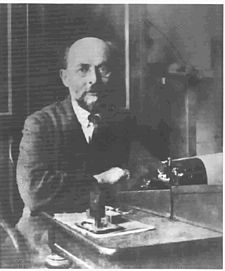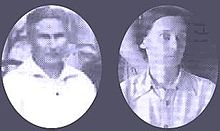- Alexander Gurwitsch
-
Alexander Gurwitsch 
Born September 26, 1874
Poltava, Ukraine, Russian EmpireDied July 27 1954
Moscow, USSRCitizenship Russia-USSR Fields Developmental biology Known for Morphogenetic Field Theory, Mitogenetic Radiation Alexander Gavrilovich Gurwitsch (also Gurvich, Gurvitch) (Russian: Алекса́ндр Гаври́лович Гу́рвич; 1874–1954) was a Russian and Soviet biologist and medical scientist who originated the morphogenetic field theory and discovered the biophoton. [1]
Contents
Early life
Gurwitch was the son of a Jewish provincial lawyer: his family was artistic and intellectual and he decided to study medicine only after failing to gain a place studying painting. After research in the laboratory of Karl Wilhelm von Kupffer he began to specialise in embryology, publishing his first paper, on the biochemistry of gastrulation, in 1895. He graduated from Munich University in 1897, having studied under A.A. Boehm.
Morphogenetic field theory
After graduation he worked in the histology laboratories of the universities of Strasbourg and Bern until 1907. At this time he met his future wife and life-long collaborator, the Russian-born medical trainee Lydia Felicine. His continuing interest, with the help of his relative Leonid Mandelstam, in the advances in physics at that time was to help in the formulation of his morphogenetic field theory, which Gurwitsch himself viewed throughout his life as no more than a suggestive hypothesis.
Serving in 1904 with the Russian army in the field he had much time to think, and he reasoned with himself that even a full understanding of every developmental process might not provide, or even necessarily lead to, a sense of understanding of ontogeny as a whole: a holistic, "top-down" model was needed to explain the ordered sequence of such individual processes. This conviction led him to adopt field theory as an embryological paradigm. His ideas had much in common with his contemporary Driesch and the two developed a mutual professional admiration.[2]
During the next decade Gurwitsch contributed a series of landmark papers arguing that the orientation and division of cells was random at local level but was rendered coherent by an overall field which obeyed the regular inverse square law - an enterprise that required extensive statistical analysis. In 1907 he published his general treatise Atlas and Outline of Embryology of Vertebrates and of Man.
The Biophoton
After the 1917 revolution Gurwitsch fell upon hard times and accepted the chair of Histology at Taurida University, the chief seat of learning of the Crimean Peninsula, where he spent seven happy years. Here in 1923 he first observed biophotons or ultra-weak biological photon emissions; weak electromagnetic waves which were detected in the ultra-violet range of the spectrum.
Gurwitsch named the phenomenon mitogenetic radiation since he believed that this light radiation allowed the morphogenetic field to control embryonic development. His published observations, which related that cell-proliferation of an onion was accelerated by directing these rays down a tube, brought him great attention. Some five hundred attempts at replication, however, produced overwhelmingly negative results, so that the idea was neglected for decades until it commanded some renewed interest in the later 20th century.[3] However the furore, which may have sparked Wilhelm Reich's similar Orgone experiments, brought Gurwitsch an international reputation that led to several European lecture-tours. His work influenced that of Paul Alfred Weiss in particular.
Later life
Gurwitsch was Professor of Histology and Embryology at Moscow University from 1924 to 1929 but fell foul of the communist party and was forced to relinquish the chair. He then directed a laboratory at the Institute of Experimental Medicine in Leningrad from 1930 until 1945, though he was forced to evacuate during World War 2. In 1941 he was awarded a Stalin Prize for his mitogenetic radiation work since it had apparently led to a cheap and simple way of diagnosing cancer. He was director of the Institute of Experimental Biology in Leningrad from 1945 to 1948. He sought to redefine his "heretical" concept of the morphogenetic field in general essays, pointing to molecular interactions unexplained by chemistry.
Gurwitsch retired in 1948 after Trofim Lysenko came to power but continued working at home.[4] Sadly his wife Lydia died in 1951. In 1953 Irving Langmuir dubbed Gurwitsch's ideas pathological science. However his daughter, Anna, continued his work and, shortly after his death, contributed papers that supported some aspects of her father's work on "mitogenetic" rays.[5]
Legacy
Field theories of morphogenesis had a heyday in the 1920s but the success of genetics confined such ideas to the background of biology. Gurwitsch had been ahead of his time in his interest in the emergent properties of the embryo but more modern self-organization theories (see, for example, Ilya Prigogine) and treatments of non-equilibrium thermodynamics in living systems would show the extent to which the vectors he described can be generated without the assumption of an overall field, so that the search for a physical field was abandoned in favour of more neutral concepts like the paradigm of Systems Biology. The early interest in physics which inspired Gurwitsch in the end tended to render his ideas untenable.[6] The "mitogenetic ray" was one of the scientific topics qualified by Irving Langmuir as pathological science.[7]
However, the tenacity of Anna Gurwitsch, together with the development of the photon counter multiplier, resulted in the confirmation of the phenomenon of biophotons in 1962. The observation was duplicated in a western laboratory by Quickenden and Que Hee in 1974.[8] In the same year Dr. V.P.Kazmacheyev announced that his research team in Novosibirsk had detected intercellular communication by means of these rays.[9] Fritz-Albert Popp claims they exhibit coherent patterns. These studies have drawn only fringe interest.
There has been a recent revival in field theories of life, albeit again at the fringes of science, particularly among those who seek to include an account of developmental psychobiology. The influence of Gurvitch's theory is particularly evident upon the work of the plant physiologist Dr. Rupert Sheldrake.
See also
- Morphogenetic field
- Biophoton
- Developmental biology
- Regional specification
- Vitalism
- Hans Adolf Eduard Driesch
- Hans Spemann
- Paul Alfred Weiss
- Walter John Kilner
References
- ^ Developmental Biology 8e Online: The "Re-discovery" of Morphogenic Fields
- ^ This account, and much other biographical material presented here, is based upon the short biography by his grandson Lev Beloussov, which is in turn based upon Gurwitsch's own unpublished autobiographical notes. http://www.ijdb.ehu.es/web/contents.php?vol=41&issue=6&doi=9449452 - retrieved May 2008.
- ^ Brief popular accounts appear in G.L.Playfair and S.Hill, "The Cycles of Heaven" (Souvenir, 1978, Pan 1979) and S. Ostrander and L. Schroeder ,"PSI: Psychic Discoveries behind the Iron Curtain", Abacus 1973.
- ^ Vadim J. Birstein. The Perversion Of Knowledge: The True Story of Soviet Science. Westview Press (2004) ISBN 0-8133-4280-5
- ^ A.A.Gurwitsch, "Problems of mitogenetic radiation as an aspect of molecular biology", Meditaina, Leningrad 1968.
- ^ Beloussov, op.cit.
- ^ For a review and bibliography, see Hollander and Claus, J. Opt. Soc. Am., 25, 270-286 (1935)
- ^ T.I.Quickenden and S.S.Que Hee, "Weak luminescence from the yeast Saccharomyces cerevisiae and the existence of mitogenetic radiation", Biochemical and Biophysical Research Communications 60 (2) 764-9, 1974, cited in Playfair and Hill, op. cit. p. 366 n. 24.
- ^ Playfair and Hill op.cit. p107
Bibliography
- Biophotonics (L.V.Beloussov and F.-A. Popp eds) BioInform Services, Moscow, 1995.
- Biophotonics and Coherent Systems (L.V.Beloussov, F.-A. Popp, V.L. Voeikov and R. van Wijk eds) Moscow University Press, Moscow 2000.
- Biophotonics and Coherent Systems in Biology by L.V. Beloussov (Editor), V.L. Voeikov (Editor), V.S. Martynyuk (Editor), Springer Science+Business Media, LLC., 2007, New York. - 306 p.
Categories:- 1874 births
- 1954 deaths
- People from Poltava
- Ukrainian biologists
- Ukrainian cell biologists
- Ukrainian Jews
- Developmental biologists
- Cell biologists
Wikimedia Foundation. 2010.

